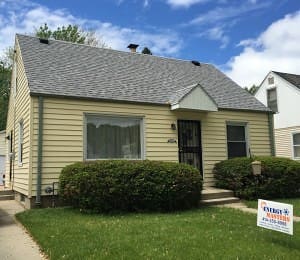There are multiple options for siding on the market today, with vinyl siding being one of the most affordable. While traditional wood or some of the wood substitutes are costly, vinyl gives you multiple choices.
The key to understanding how to do siding affordably, you have to first consider that your contractor has the fixed cost of installation, but materials offer some flexibility. That being said, you shouldn’t consider cutting too many corners.

This customer chose to use a foam backed siding on their cape cod style house to match the siding on their garage. They opted for the hollow backed siding on their garage.
Gauge of vinyl siding varies considerably. You can buy a siding with a gauge as low as .40 or as thick as .47 mils. The rule of thumb is, the thicker, the better. Thinner gauges tend to shatter or crack significantly easier when they get cold. Hollow backed siding is always cheaper than insulated, or contoured foam backed siding, but the drawback is that it has no backing to help mitigate against impacts such as snow with ice chunks or random pebbles that go through a snow blower.
Insulation varies as well. With some of your cheaper options, your contractor will use 1/4 inch “fan fold” behind the siding. Your better siding will have a contoured foam backing. There are several different types of foam backing, but rest assured, an insulation that follows the contour of your home is always going to be more durable than one without any backing.
If buying a new home, poke the siding with your finger before you walk in the door. If it easily goes in, it is hollow backed siding which may have been put on for a quick cosmetic fix and will have to be replaced sometime in the next 10 to 20 years. If it keeps its shape and does not give easily to a finger poke, it is contoured foam backed siding which you may never have to replace.
You should also consider doing a house wrap before the siding goes on. A good house wrap will keep moisture from reaching your home, reduce the energy bill impact of wind, and should any water or moisture get behind the siding, help to facilitate down the wall without causing mold.
If you’re willing to pay the price, either steel or aluminum are still available on the marketplace today, but keep in mind that cell telephone coverage may be limited in houses that are clad in steel. Add a steel roof onto a steel sided house and you will likely be limited to just using traditional wired landlines for your communication needs.

